 In this CrystEngComm Hot article Joël Moreau and colleagues create a porous network from a host compound based on spirocyclic triphosphazene.
In this CrystEngComm Hot article Joël Moreau and colleagues create a porous network from a host compound based on spirocyclic triphosphazene.
Their porous network has bigger cavity sizes and is more stable than other similiar structures, while still managing to achieve the desirable tunnel-like cavities found previously.
Read the full article for FREE to find out more about these porous networks…
Synthesis and crystal structure of tris(2,3-triphenylenedioxy)cyclotriphosphazene: a new clathration system
Mathias Reynes, Olivier J. Dautel, David Virieux, David Flot and Joël J. E. Moreau
CrystEngComm, 2011, DOI: 10.1039/C1CE05529A














 Guoqi Zhang, Guoqiang Yang and coworkers from the Chinese Academy of Sciences, Beijing make a series of bis(pyrrolyl)carbohydrazide derivatives in this CrystEngComm Hot article.
Guoqi Zhang, Guoqiang Yang and coworkers from the Chinese Academy of Sciences, Beijing make a series of bis(pyrrolyl)carbohydrazide derivatives in this CrystEngComm Hot article. José Giner Planas and colleagues from the Institut de Ciència de Materials de Barcelona (ICMAB-CSIC), and Mark E. Light and Michael B. Hursthouse from the University of Southampton look at methyl-o-carboranyl and o-carboranyl alcohols bearing N-aromatic rings in this CrystEngComm Hot article.
José Giner Planas and colleagues from the Institut de Ciència de Materials de Barcelona (ICMAB-CSIC), and Mark E. Light and Michael B. Hursthouse from the University of Southampton look at methyl-o-carboranyl and o-carboranyl alcohols bearing N-aromatic rings in this CrystEngComm Hot article. In this CrystEngComm Hot article, Roberto Otero and colleagues from Spain self assemble zinc meso-tetramesitylporphyrin on copper and gold into one-dimensional nanorods.
In this CrystEngComm Hot article, Roberto Otero and colleagues from Spain self assemble zinc meso-tetramesitylporphyrin on copper and gold into one-dimensional nanorods. Read this CrystEngComm Hot article to discover how the Kirkendall effect can be used to make BiOI nests.
Read this CrystEngComm Hot article to discover how the Kirkendall effect can be used to make BiOI nests.
 In this HOT article, Babashkina and co-workers have synthesized the first examples of NiII complexes containing the same asymmetric NTT [(N-(thio)phosphorylated thioamides and thioureas RC(S)NHP(X)(OR0)2 (X ¼ O, S)] ligand featuring an aryl-NH substituent at the thiocarbonyl group and coordinating to the metal both in the 1,3-N,S- and 1,5-S,S’-fashion in the solid state depending on the crystallization conditions.
In this HOT article, Babashkina and co-workers have synthesized the first examples of NiII complexes containing the same asymmetric NTT [(N-(thio)phosphorylated thioamides and thioureas RC(S)NHP(X)(OR0)2 (X ¼ O, S)] ligand featuring an aryl-NH substituent at the thiocarbonyl group and coordinating to the metal both in the 1,3-N,S- and 1,5-S,S’-fashion in the solid state depending on the crystallization conditions. Song Gao and colleagues from Peking University investigate a way of improving the chances of obtaining chiral crystalline solids, in this CrystEngComm Hot article.
Song Gao and colleagues from Peking University investigate a way of improving the chances of obtaining chiral crystalline solids, in this CrystEngComm Hot article.